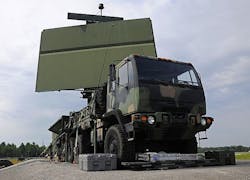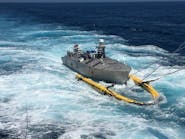Raytheon moves forward with 3DELRR radar to protect warfighters from missiles and unmanned aircraft
HANSCOM AIR FORCE BASE, Mass. – Radar experts at the Raytheon Co. are moving forward with full-scale development of a portable air-defense radar system intended to detect, identify and track enemy missiles as well as manned and unmanned aircraft.
Officials of the U.S. Air Force Life Cycle Management Center at Hanscom Air Force Base, Mass., announced a $52.7 million contract last week to the Raytheon Integrated Defense Systems segment in Woburn, Mass., to build three advanced-development versions of the Three-Dimensional Expeditionary Long-Range Radar (3DELRR) System.
The 3DELRR radar is to replace the Air Force's Northrop Grumman AN/TPS-75 transportable 3-D passive electronically scanned array air search radar for enabling U.S. and allied invasion forces to protect themselves from airborne threats after establishing beachheads.
Raytheon won a potential $71.8 million contract in October 2014 to begin 3DELRR engineering and manufacturing development (EMD). In its selection for the 3DELRR program, pronounced "three-dealer," Raytheon prevailed over other U.S. top-tier radar houses competing for this contract, including Lockheed Martin Corp. and Northrop Grumman Corp.
After award of the 2014 3DELRR, Northrop Grumman and Lockheed Martin lodged protests of award to Raytheon. Last week's contract confirms Raytheon as the 3DELRR prime contractor, and resolves the protests from Raytheon and Lockheed Martin.
Last week's contract covers EMD of three production-representative units, but allows the ability to exercise options for low-rate production, interim contractor support, and full-rate production when appropriate, Air Force officials say.
Raytheon's 3DELRR system is a C-band gallium nitride (GaN)-based radar. GaN technology helps increase the radar's range, sensitivity, and search capabilities, while operating in C-band offers increased flexibility because that portion of the spectrum is relatively uncongested, Raytheon officials say.
3DELRR will be the principal Air Force long-range, ground-based sensor for detecting, identifying, tracking, and reporting aerial targets for the Joint Force Air Component Commander through the Theater Air Control System, Air Force officials say.
Related: Marines make transition from gallium arsenide to gallium nitride in air-defense radar
The 3DELRR system is designed to deal with regional and near-peer conflicts of the future that could involve large numbers of enemy advanced unmanned aerial vehicles (UAVs), fixed-wing aircraft, helicopters, and ballistic and cruise missiles, Raytheon officials say.
3DELRR is designed to detect, identify and track a wide variety of objects accurately at great distances, Raytheon officials say. C-band, moreover, is a relatively uncongested portion of the electromagnetic spectrum. The radar is interoperable with coalition systems and meet the requirements of many foreign militaries, company officials say.
The 3DELRR system is similar to the Ground/Air Task-Oriented Radar (G/ATOR) that Northrop Grumman is building the for U.S. Marine Corps. G/ATOR is being developed to protect Marine Corps expeditionary forces from rockets, artillery, mortars, cruise missiles, UAVs, and other low observables. It is a deployable short-to-medium-range multi-role radar system. 3DELRR, on the other hand, is designed to detect and track threats at longer ranges.
Like 3DELRR, the G/ATOR is based on GaN technology, yet the G/ATOR system is designed to handle air surveillance, weapon cueing, counter-fire target acquisition, and air traffic control for Marine Corps warfighters operating in invasion beaches.
Related: Army approaches industry to ways to upgrade or replace Patriot missile-defense radar system
The Raytheon 3DELRR initial $19.5 million contract awarded two years ago involved system EMD, low-rate initial production (LRIP), and interim contractor support (ICS). The contract was for purchase of three radar systems, and has options worth about $71.8 million for three additional radar systems.
The 3DELRR will provide the Air Force control and reporting center with real-time data to display air activity, and will provide warning and target information.
The system also will provide operators with a precise, real-time air picture to provide air traffic control services to individual aircraft across a wide range of environmental and operational conditions.
On last week's contract Raytheon will do the work in Andover, Mass., and should be finished by November 2020. For more information contact Raytheon Integrated Defense Systems online at www.raytheon.com, or the Air Force Life Cycle Management Center at www.wpafb.af.mil/aflcmc.
Learn more: search the Aerospace & Defense Buyer's Guide for companies, new products, press releases, and videos

John Keller | Editor
John Keller is editor-in-chief of Military & Aerospace Electronics magazine, which provides extensive coverage and analysis of enabling electronic and optoelectronic technologies in military, space, and commercial aviation applications. A member of the Military & Aerospace Electronics staff since the magazine's founding in 1989, Mr. Keller took over as chief editor in 1995.



